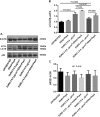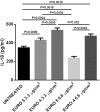Diesel exhaust particles induce autophagy and citrullination in Normal Human Bronchial Epithelial cells
- PMID: 30341285
- PMCID: PMC6195610
- DOI: 10.1038/s41419-018-1111-y
Diesel exhaust particles induce autophagy and citrullination in Normal Human Bronchial Epithelial cells
Abstract
A variety of environmental agents has been found to influence the development of autoimmune diseases; in particular, the studies investigating the potential association of systemic autoimmune rheumatic diseases with environmental micro and nano-particulate matter are very few and contradictory. In this study, the role of diesel exhaust particles (DEPs), one of the most important components of environment particulate matter, emitted from Euro 4 and Euro 5 engines in altering the Normal Human Bronchial Epithelial (NHBE) cell biological activity was evaluated. NHBE cells were exposed in vitro to Euro 4 and Euro 5 particle carbon core, sampled upstream of the typical emission after-treatment systems (diesel oxidation catalyst and diesel particulate filter), whose surfaces have been washed from well-assessed harmful species, as polycyclic aromatic hydrocarbons (PAHs) to: (1) investigate their specific capacity to affect cell viability (flow cytometry); (2) stimulate the production of the pro-inflammatory cytokine IL-18 (Enzyme-Linked ImmunoSorbent Assay -ELISA-); (3) verify their specific ability to induce autophagy and elicit protein citrullination and peptidyl arginine deiminase (PAD) activity (confocal laser scanning microscopy, immunoprecipitation, Sodium Dodecyl Sulphate-PolyAcrylamide Gel Electrophoresis -SDS-PAGE- and Western blot, ELISA). In this study we demonstrated, for the first time, that both Euro 4 and Euro 5 carbon particles, deprived of PAHs possibly adsorbed on the soot surface, were able to: (1) significantly affect cell viability, inducing autophagy, apoptosis and necrosis; (2) stimulate the release of the pro-inflammatory cytokine IL-18; (3) elicit protein citrullination and PAD activity in NHBE cells. In particular, Euro 5 DEPs seem to have a more marked effect with respect to Euro 4 DEPs.
Conflict of interest statement
The authors declare that they have no conflict of interest.
Figures







Similar articles
-
Diesel exhaust particulate emissions and in vitro toxicity from Euro 3 and Euro 6 vehicles.Environ Pollut. 2022 Mar 15;297:118767. doi: 10.1016/j.envpol.2021.118767. Epub 2021 Dec 30. Environ Pollut. 2022. PMID: 34974087
-
Physico-chemical properties and biological effects of diesel and biomass particles.Environ Pollut. 2016 Aug;215:366-375. doi: 10.1016/j.envpol.2016.05.015. Epub 2016 May 15. Environ Pollut. 2016. PMID: 27194366
-
Diesel exhaust particles induce CYP1A1 and pro-inflammatory responses via differential pathways in human bronchial epithelial cells.Part Fibre Toxicol. 2010 Dec 16;7:41. doi: 10.1186/1743-8977-7-41. Part Fibre Toxicol. 2010. PMID: 21162728 Free PMC article.
-
The dual effect of the particulate and organic components of diesel exhaust particles on the alteration of pulmonary immune/inflammatory responses and metabolic enzymes.J Environ Sci Health C Environ Carcinog Ecotoxicol Rev. 2002 Nov;20(2):117-47. doi: 10.1081/GNC-120016202. J Environ Sci Health C Environ Carcinog Ecotoxicol Rev. 2002. PMID: 12515672 Review.
-
Particulate matter in new technology diesel exhaust (NTDE) is quantitatively and qualitatively very different from that found in traditional diesel exhaust (TDE).J Air Waste Manag Assoc. 2011 Sep;61(9):894-913. doi: 10.1080/10473289.2011.599277. J Air Waste Manag Assoc. 2011. PMID: 22010375 Review.
Cited by
-
The Construction of Bone Metastasis-Specific Prognostic Model and Co-expressed Network of Alternative Splicing in Breast Cancer.Front Cell Dev Biol. 2020 Aug 25;8:790. doi: 10.3389/fcell.2020.00790. eCollection 2020. Front Cell Dev Biol. 2020. PMID: 32984314 Free PMC article.
-
Cellular Mechanisms Involved in the Combined Toxic Effects of Diesel Exhaust and Metal Oxide Nanoparticles.Nanomaterials (Basel). 2021 May 29;11(6):1437. doi: 10.3390/nano11061437. Nanomaterials (Basel). 2021. PMID: 34072490 Free PMC article.
-
Asthma and elevation of anti-citrullinated protein antibodies prior to the onset of rheumatoid arthritis.Arthritis Res Ther. 2019 Nov 21;21(1):246. doi: 10.1186/s13075-019-2035-3. Arthritis Res Ther. 2019. PMID: 31753003 Free PMC article.
-
Degenerative and Regenerative Actin Cytoskeleton Rearrangements, Cell Death, and Paradoxical Proliferation in the Gills of Pearl Gourami (Trichogaster leerii) Exposed to Suspended Soot Microparticles.Int J Mol Sci. 2023 Oct 13;24(20):15146. doi: 10.3390/ijms242015146. Int J Mol Sci. 2023. PMID: 37894826 Free PMC article.
-
The utility of alternative models in particulate matter air pollution toxicology.Curr Res Toxicol. 2022 May 27;3:100077. doi: 10.1016/j.crtox.2022.100077. eCollection 2022. Curr Res Toxicol. 2022. PMID: 35676914 Free PMC article.
References
-
- Durga M, Nathiya S, Rajasekar A, Devasena T. Effects of ultrafine petrol exhaust particles on cytotoxicity, oxidative stress generation, DNA damage and inflammation in human A549 lung cells and murine RAW 264.7 macrophages. Environ. Toxicol. Pharmacol. 2014;38:518–530. doi: 10.1016/j.etap.2014.08.003. - DOI - PubMed
Publication types
MeSH terms
Substances
LinkOut - more resources
Full Text Sources
Miscellaneous

